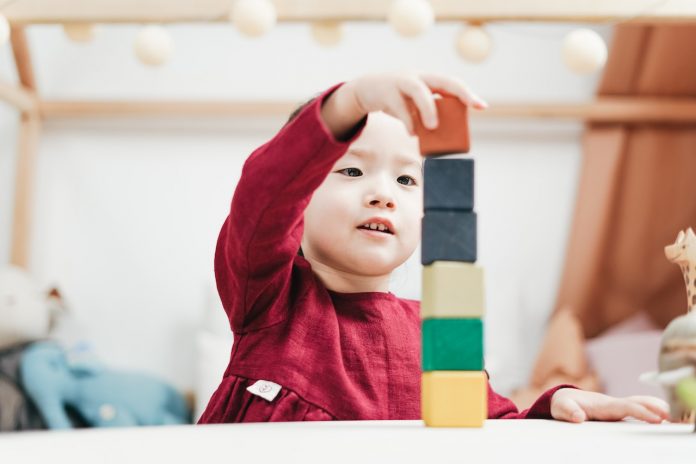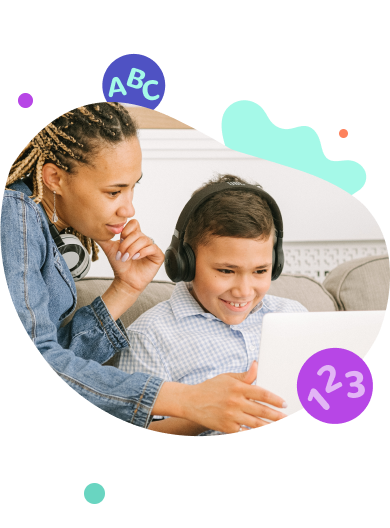Toddlers are very active and always on the go! As a parent, it can be tough to keep up with their energy levels. However, it’s important to find ways to keep your toddler occupied and engaged and learning!
Math & ELA | PreK To Grade 5
Kids see fun.
You see real learning outcomes.
Watch your kids fall in love with math & reading through our scientifically designed curriculum.
Parents, try for free Teachers, use for free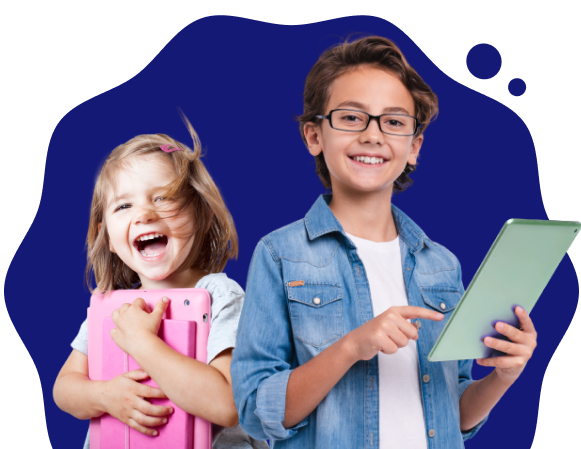
Here are 15 activities for 3-year-olds that are both fun and educational:
6 Fun Developmental Activities for 3-Year-Olds
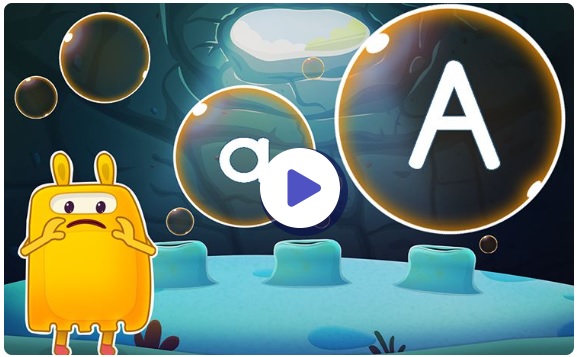
1. Recognizing Letters and Sounds
Learning activities for 3-year-olds are most fun when they are dressed up as family games, pretend plays, or become parts of our daily activities and observations. Recognizing letters and their sounds is one such activity that can be done in several ways.
Things you need:
A whiteboard or chalkboard, some colored markers or chalk. You can also use letter cards, board games, or online games for kids.
How to play:
You can play games where you write a letter on the board and teach your child to read it. Preschoolers can start learning both uppercase and lowercase letters. If they get it right, give them a point. If not, give them a clue and let them try again.
You can also play the “sound it out” game. Write a letter on the board and ask your child to make the sound it makes. Again, if they get it right, give them a point. If not, give them a clue and let them try again.
Pointing to letters written somewhere as you go about your day—a cereal box, a signboard, a magazine, etc.—is also an easy activity to help your child learn to read them. Children can also trace letters with their fingers on the sand, match uppercase and lowercase letters, erase letters on a chalkboard, etc.
If you are busy, play some alphabet songs for your toddler to dance or let them play some online English games.
Skills your preschooler will learn:
Letter recognition, phonemic awareness, letter sounds
2. Listen to Fun A-Z Alphabet Songs
Introduce your little one to the magical world of letters with A-Z alphabet songs! Sing along to catchy tunes that make learning the alphabet a fun and engaging experience. These songs help children recognize letter shapes and sounds while building their phonemic awareness. Perfect for car rides or playtime, alphabet songs turn learning into a joyful sing-along adventure!
3. Reading with Your Child
Reading books with your child is one of the best things you can do for their development. Not only does it improve language skills, but it also helps them learn sight words, develop their imagination, and understand the world around them.
Things you need:
Books that are appropriate for your child’s age and interests, such as picture books, easy readers, etc.
How to play:
Sit down with your child and read a book together. You can take turns reading the pages or have your child read the whole book to you.
Books for toddlers should be short and have many pictures supporting the story. This will help keep their attention span, and they will be more likely to understand the concepts in the book.
Read word by word, pointing to each word with your finger, and ask inferential questions based on how, why, what, when, and where to encourage the thinking skills in kids.
Skills your preschooler will learn:
Language skills, sight words, attention span, comprehension, memory, imagination
4. Making Up Stories
Children love to listen to and tell stories, and this is an activity that can be done anywhere, anytime. It’s the perfect thing to do in a car while traveling, at bedtime, or even while waiting in line at the grocery store.
Things you need:
None! Just your child’s imagination
How to play:
Have your child make up a story, either on their own or with your help. Encourage them to use their imagination and be as creative as they want. If they get stuck, you can prompt them with questions or ideas. You may also correct their grammar along the way, but it’s important to let them be creative and have fun with this activity.
If your child is stumped, set an example by asking them for three or four words and make a story that uses all of them. For instance, if they give you the words “cat,” “green,” “ball,” and “tree,” you could make up a story about a green cat that climbs a tree to fetch a ball.
Eventually, you can give words to your child and have them make up a story using those words.
Skills your preschooler will learn:
Creativity, imagination, storytelling, communication
Related Reading: Amazing Short Stories for Kids That Teach Beautiful Lessons
5. Playing a Number Game
Offline and online, math can be fun for kids if it’s taught interactively and creatively. Playing the number sense games is one such activity that will help your child learn numbers, counting, and basic arithmetic operations in a fun and engaging way.
Things you need:
A whiteboard or a chalkboard, some colored markers or chalk. You can also use games focusing on numbers and counting, such as board games, card games, etc. Online math games are also available.
How to play:
There are many games that you can play with your child to help him learn numbers and math concepts. One such game is the “guess the number” game. Write down a number between 1 and 10 on the board, and ask your child to guess it. If he gets it right, give him a point. If not, give him a clue and let him have another try.
You can also play the “greater than or less than” game. Write down two numbers on the board, such as 3 and 5, and ask your child which number is greater. If he gets it right, give him a point. If not, give him a clue and let him try again.
Skills your preschooler will learn:
Numbers, counting, and basic arithmetic operations include addition, subtraction, multiplication, and division.
6. Sorting Activities
Sorting is a fun activity that helps children learn about different attributes such as size, shape, color, etc. It also helps them develop problem-solving skills.
Things you need:
Various objects can be sorted according to size, shape, color, etc. You can use blocks, balls, toy cars, berries, buttons, etc.
How to play:
Let your child choose a few objects and ask him to sort them according to size, shape, color, etc. For example, they can sort blocks by size or toy cars by color. As they sort the objects, help them identify the attribute they use for sorting.
Skills your preschooler will learn:
Sorting, categorizing, and problem-solving.
Check out the best sensory activities for 3-year-olds you can try!
5 Indoor Activities for 3-Year-Olds
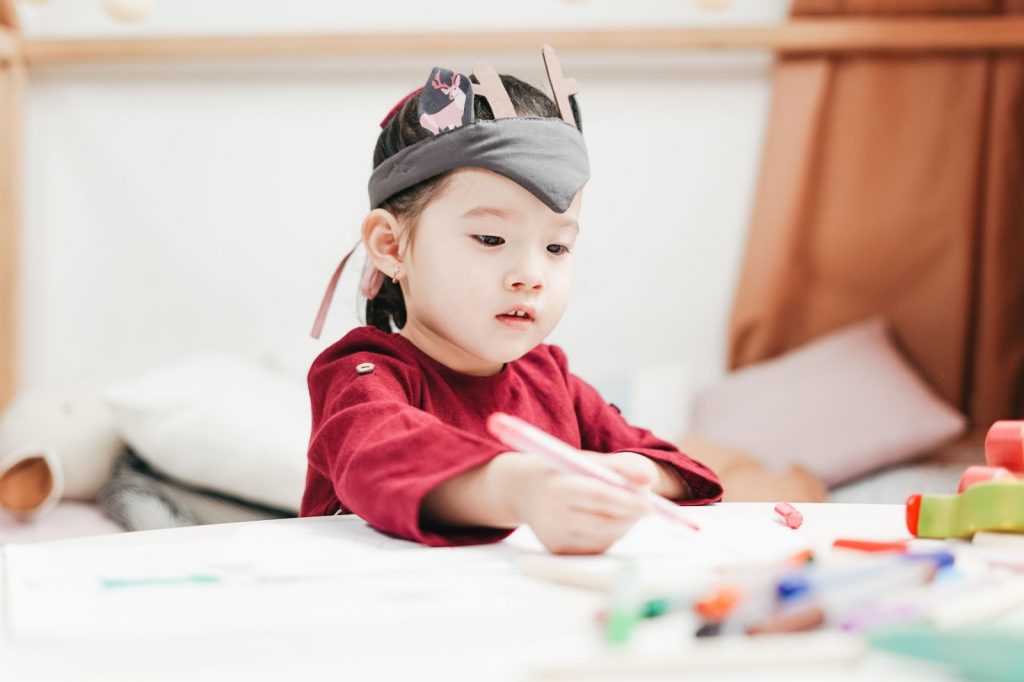
6. Drawing
One of the favorite preschool activities for 3-year-olds is drawing. At this point, the artistic skills of a child are not really important. Drawing is a fun activity for toddlers to express themselves, work on their fine motor skills, and have fun!
Things you need:
Paper, crayons, markers, colored pencils
How to play:
Sit with your child and encourage them to draw whatever comes to mind. You can also give some drawing ideas to kids, such as “Draw a picture of your family,” “Draw a picture of your favorite animal,” etc. You may make a drawing and ask your child to trace it or copy it.
Skills your preschooler will learn:
Creativity, fine motor skills, imagination, attention span
7. Building with Blocks
One of the easy, no-mess activities for 3-year-olds at home is to let them build with blocks. It is amazing how much fun and creative they can be with this simple activity.
Blocks are also a great way for children to learn about shapes, sizes, colors, and patterns.
Things you need:
Blocks of various shapes and sizes
How to play:
Let your child play with the blocks freely or give him or her some challenges, such as “build a tower as tall as you can,” “make a house for your favorite stuffed toy,” etc.
Skills your preschooler will learn:
Creativity, imagination, problem-solving, eye-hand coordination, shapes, colors, patterns
Related Reading: Minute Best Crafts for Kids to Make at Home
8. Paper Cutting with Safety Scissors
Children feel empowered with a tool in their hands. And they are so proud of themselves when they can cut the paper!
Things you need:
Paper, safety scissors, craft supplies like pom poms, googly eyes (optional)
How to play:
Give your child a piece of paper and let him or her cut it any way they want. If you like, you can also give some challenges, such as “cut out a circle,” “make a snowflake,” etc. You can help your child decorate the cutouts with craft supplies if desired.
Skills your preschooler will learn:
Fine motor skills, creativity, imagination, attention span
*Please note that only safety scissors should be used for this activity. Regular scissors are too sharp for little ones.*
9. Doing Daily Chores
You’ll be surprised at all the things your toddlers can do if only you let them try. Giving them some simple chores to do not only helps them learn some valuable life skills but also makes kids feel proud and accomplished.
Things you need:
Chores that are appropriate for your child’s age and abilities, such as making their bed, dusting furniture, setting the table, etc.
How to play:
Choose a chore that you would like your child to help with. Then, show them how to do it and let them try it themselves. Some of the chores that a 3-year-old can do may require some assistance or supervision, but it’s important to let them explore their capabilities and try new things.
A toddler can easily be overwhelmed with too many chores, so it’s important to start small. Choose one or two simple tasks that you know your child can handle. As they get older and more capable, you can give them more chores to do. Remember to praise them for a job well done!
Skills your preschooler will learn:
Daily living skills, responsibility, independence, pride, satisfaction
10. Role-playing
What’s funnier than seeing a tiny toddler acting like a fat aunt or an old grandpa? Role-plays are one of the best activities for 3-year-olds as they help them learn about different emotions, people, and situations.
Things you need:
None! Just your child’s imagination. A few props like a walking stick, a hat, a lady’s purse, or a wig could come in handy to help set the scene.
How to play:
Have your child choose a character that he or she would like to play. It could be anyone—a family member, a friend, a cartoon character, an animal, etc. Then, encourage them to act out the part. They can speak differently, use props, and do whatever they want to bring the character to life. Children learn to observe people around them and understand their emotions in this way.
Skills your preschooler will learn:
Creativity, imagination, emotional intelligence, communication, problem-solving
Check out the best outdoor activities for 3-year-olds here!
5 Engaging Art Activities for 3-Year-Olds
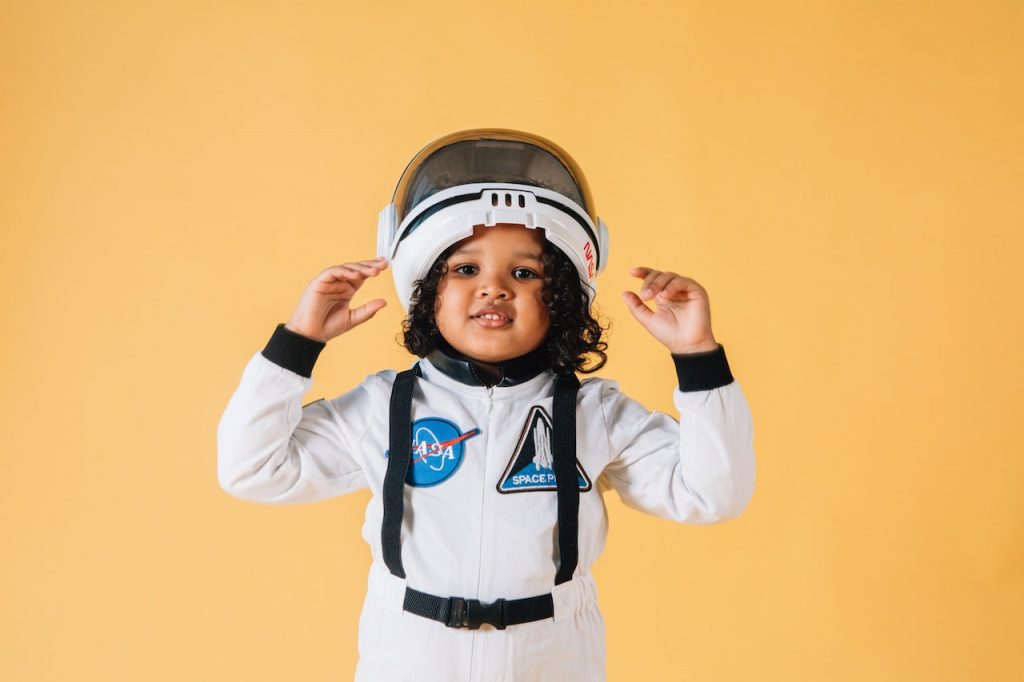
11. Playing Dress Up
Dress-up games are not gender-specific. Most children love them! This activity helps 3-year-olds use their imagination, learn about social norms and roles, and have lots of fun!
Things you need:
Old clothes, hats, scarves, jewelry, etc., can be used as dress-up items. You can also use old sheets or towels to make capes or skirts. You can also use actual costumes if you have them.
How to play:
Let your child choose what they want to be, and then help them get dressed in the appropriate clothing. If you like, you can also act out a play or story together with your child in their new costume.
Skills your preschooler will learn:
Creativity, imagination, role-playing, problem-solving
12. Making Music with Household Items
This is one of the fun activities for 3-year-olds that can be done with items that you already have around the house. It’s a great way to introduce your child to music and help them develop a sense of rhythm.
Things you need:
Household items that can be used as musical instruments, such as pots and pans, plastic containers, wooden spoons, etc. You can also use actual musical instruments if you have them.
How to play:
Let your child choose what he or she wants to use as an instrument. Then, encourage them to make music with it however they want. You can also sing along or dance to the music!
Skills your preschooler will learn:
Music skills, sense of rhythm, gross motor skills, creativity, imagination
Related Reading: Best ABC Song for Kids That Will Make Them Dance & Enjoy
13. Making Art with Thumb, Hand, or Foot Impressions
Most toddlers do not know how to go about making an art piece. But they love to play a role in helping make one! This activity allows them to do just that, resulting in a beautiful piece of art that you can hang on your fridge or wall.
Things you need:
Non-toxic paint, paper, and something to use as a stamp (such as potato, carrot, or eraser)
How to play:
Let your child choose what paint color he or she wants to use. Then, help them make a thumbprint, handprint, or footprint on the paper. You can also make patterns with stamps by carving a shape into a potato, carrot, or eraser. Once the paint is dry, you can hang up the artwork!
Skills your preschooler will learn:
Creativity, imagination, fine motor skills, color recognition
14. Creating a Collage
A collage is a great way for toddlers to express their creativity. They can make amazing birthday cards with photo collages, make wall-hanging art, or have fun tearing up paper and gluing it back together!
Things you need:
Paper, safety scissors, glue, and any other materials you want to use for the collage (such as tissue paper, construction paper, feathers, buttons, ribbons, etc.)
How to play:
Let your child choose what they want to use for their collage. Then, help them cut out the paper or other materials into small pieces. Once they have a good pile of pieces, they can glue them down onto another piece of paper. You can help them with this if needed.
Skills your preschooler will learn:
Creativity, imagination, fine motor skills, color recognition, pattern-making
15. Drawing with Chalk on the Sidewalk
If you live in a safe neighborhood, your children can display their artistic skills outside the home by drawing with chalk on the sidewalk or driveway. This activity is great for gross motor skills and allows you to teach your child about shapes, colors, and patterns.
Things you need:
Chalk in various colors
How to play:
Let your child choose what color of chalk he or she wants to use. Then, help them draw a picture or make patterns on the sidewalk. You can also join in and create your own chalk masterpiece!
Educate children about different cultures where making art to decorate entrance gates and doorways is a tradition. Indians make rangoli, Chinese make a dragon or zodiac animal drawings, while in the Philippines, it is common to see people painting on bamboo mats called banig. In this way, you can introduce your toddlers to other cultures.
Skills your preschooler will learn:
Creativity, imagination, gross motor skills, shapes, colors, pattern-making
Related Reading: Benefits of Culturally Responsive Teaching
How Educational Activities Transform Kids’ Lives
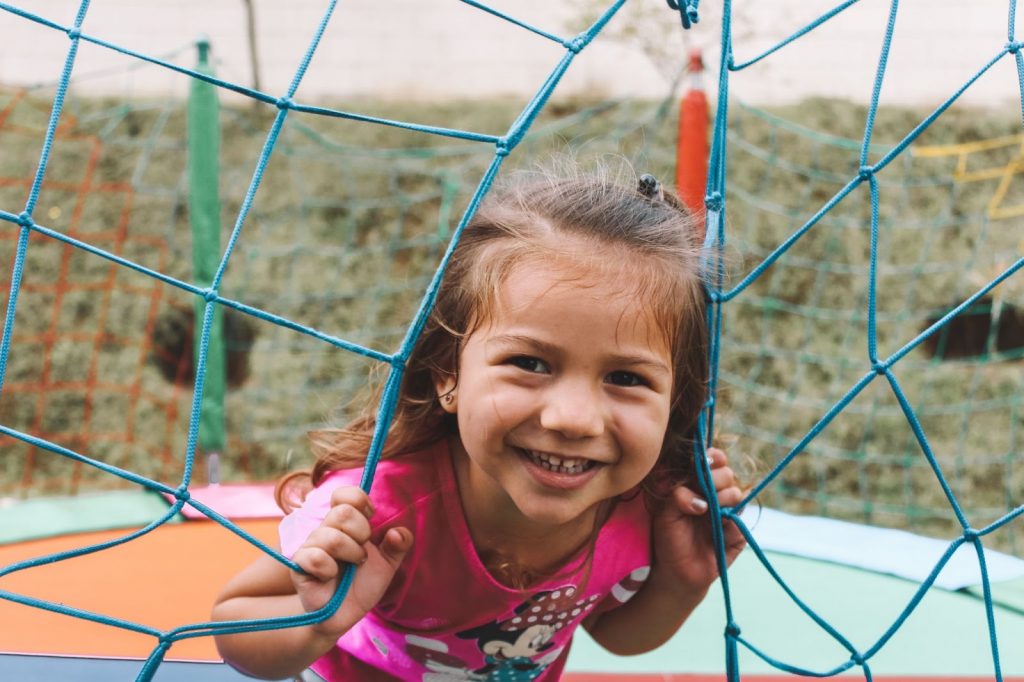
A study on Chinese children found that organized extracurricular activities (EAs) are strongly associated with early reading, math, and social skills. Another study indicated that the involvement of parents in preschool children’s learning activities at home during the COVID-19 pandemic was beneficial to kids’ learning behavior and emotional health.
These studies seem to suggest that any activity that encourages learning, socialization, and creativity would benefit our little ones and shape them into more confident, woke, and aware individuals.
Some benefits of educational activities for 3-year-olds are:
- They help develop cognitive skills, including problem-solving, memory, and attention span.
- EAs also nurture social skills such as cooperation, empathy, and communication.
- These activities can also boost self-esteem and confidence in children.
- Fun and educational activities are also great for developing gross and fine motor skills.
So go ahead and try out some educational activities with your 3-year-old today! You might just be surprised at how much they enjoy it—and how much they learn from it too.
Explore more online educational resources for kids to aid their learning experience.
Frequently Asked Questions (FAQs)
How to choose a good educational activity for my 3 year old?
When choosing an activity for your 3-year-old, it is important to consider their interests, abilities, and attention span. You also want to ensure the activity is developmentally appropriate and safe. If you are unsure whether an activity is appropriate for your child, you can always consult their pediatrician or a child development expert.
How can I get my toddler to sit still and focus on an activity?
This can be a challenge for many parents! One tip is to try to find activities that your child is interested in and that they enjoy doing. Also, make sure you provide plenty of breaks during the activity so that your child doesn’t become overwhelmed or frustrated. Finally, praise your child when they display good behavior so that they know that you are pleased with their efforts.
How to help my toddler express their creativity?
There are many ways in which you can help your toddler express their creativity. One way is to provide plenty of opportunities for them to explore different materials and mediums, such as crayons, paint, clay, etc. You can also encourage them to sing, dance, or act out stories. And finally, make sure to praise their efforts and creativity, no matter what the outcome may be.

















